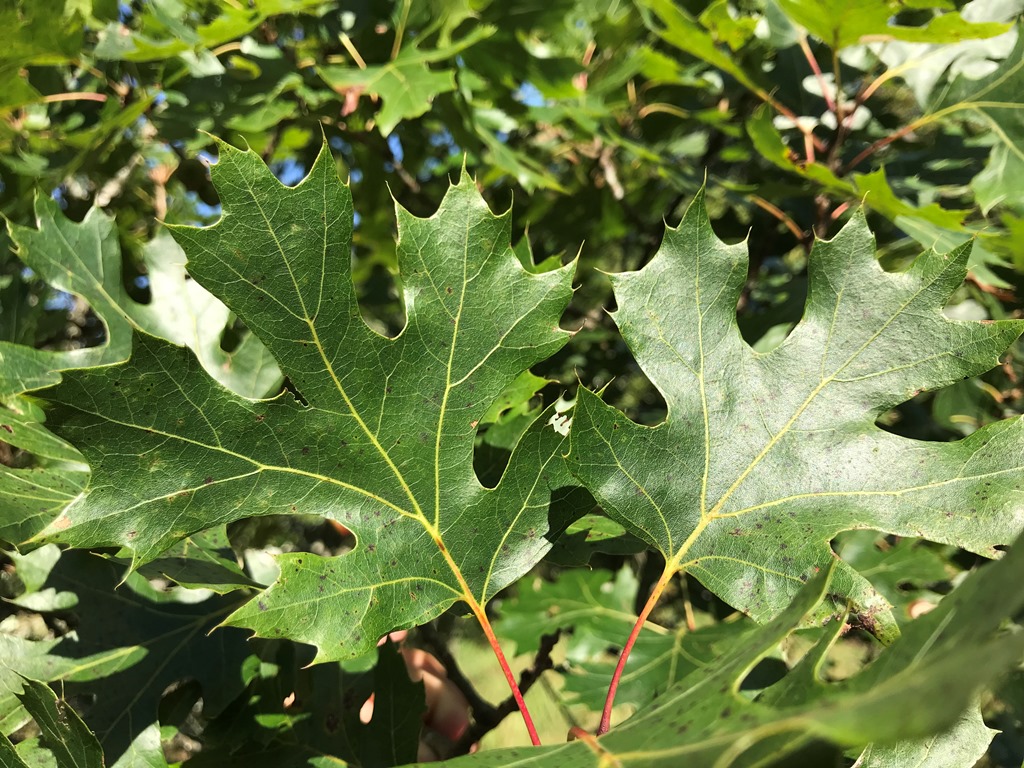Editor's Picks
Plant Focus
As most oak enthusiasts will know, Quercus acerifolia (maple-leaf oak) is listed as Endangered in the IUCN Red List of Threatened SpeciesTM and is a highly sought-after species in cultivation. Extant in only four known locations in Arkansas, the species is of conservation concern due to its reduced wild population and restricted range. It was originally described in 1926 by renowned botanist Ernest Palmer as Q. shumardii var. acerifolia, and promoted to species status in 1990 by authors Nick Stoynoff and Bill Hess. At that time, only one site (Mt. Magazine) was known to science. Three more sites have been located in recent years, and maybe (hopefully) more sites will be located in the future.

Intrigued by the rarity of this species, driven by the desire to help conserve it, and confident that it would survive in my area, I decided to grow a grove of maple-leaf oaks. This planting will comprise individuals from each site. Three to five plants of seedling origin and three to five grafted plants from each site will make up the final planting. Given the nature of each site and the relatively few individuals in existence, preservation is a concern. In time, the trees we propagate will be planted at Stephens Lake Park Arboretum in Columbia, Missouri and will become an important ex-situ germplasm repository for the species.

In order to collect the acorns and scions needed to build this collection, I had to apply for the proper permits and visit each site. Two sites are located in the Ouachita National Forest, one at Mt. Magazine State Park, and another, the newest location, on private property. In June 2019 I met up with Amanda Wu, PhD candidate from University of Missouri–St. Louis, staff from Missouri Botanic Garden, and Brent Baker, Botanist for the Arkansas Natural Heritage Commission, at the first location in the Ouachita NF. Amanda and Brent were working on separate projects and I was there scouting for a return trip in the fall. This location was a mile hike from the parking spot with an overall 800 ft elevation increase. It was a steep and arduous hike and at times I thought my knee would hit my chest with each step. The maple-leaf oaks here are growing in a narrow band along an exposed ridge top just over 1,600 ft elevation with around 30 individuals. I noted a few putative hybrids with Q. marilandica and Q. rubra, as well as other noteworthy species such as Ilex vomitoria, Ilex opaca, and Fagus grandifolia. Interestingly, as the sides of the ridge fell off in any direction, the Q. acerifolia disappeared. This site was overrun with catbrier (Smilax sp.), making each step difficult. I left that site with multiple holes in my pants and bloody legs and hands.

The following day, Brent Baker and I continued to the second Ouachita NF site. This site proved a tougher hike than the day before. It had the added problem of a locked National Forest Service gate, but luckily Brent had secured a key to the front gate, saving us an extra two miles of hiking. With more than a mile still to hike, we set off across the side of the mountain on a steep incline through poison ivy (Toxicodendron radicans), more catbrier, loose gravel, and signs of bear activity. After what seemed like an eternity, we finally arrived at the maple-leaf oaks. This ridge is a little wider than the first one, higher in elevation (up to 2,000 ft), and more individuals of Q. acerifolia were found there (~40). Typically for the species, both sites produce multi-stemmed, shrubby plants around 15-20 ft tall by 10-15 ft wide with variable maple-like foliage. Associated species included Amorpha ouachitensis, Q. stellata, Q. marilandica, and loads of Polygonum serotinum.

The next day I quickly hit Mt. Magazine State Park as well as the spot on private property near the Oklahoma border. Since I was just scouting, I could move a lot faster than the others, so we had parted ways the day before. Mt. Magazine has around 15 individuals (that I found) and the highest elevation where I recorded specimens was more than 2,500 ft. Associated species were similar to the first two sites with some other species not mentioned previously, like Baptisia sp., Crataegus engelmannii, and Chionanthus virginicus. I noted the locations of the oaks and headed an hour or so west to the other location. After scouting the last location for only a few minutes, it became clear it had the largest population I had seen yet. I didn’t stop to count, but easily over 100 individuals were seen, with some very old, large specimens; one nearing 30 ft tall with a stem diameter of over 12 inches. This site was over 1,900 ft in elevation and at the top of the ridge the maple-leaf oaks dominated. Occasionally a Q. muehlenbergii or Q. rubra could be seen, but these species seemed to stay on the slopes of the ridge.

Unfortunately, I was unable to obtain a collection permit from the Mt. Magazine/Ozark National Forest, but I shall again try next year. However I did get proper documentation from the other sites, so in September I returned ready to collect. I had followed the direction of members of a 2017 collection trip, which included people from The Morton and Dawes Arboretums. They collected on September 11-12, and I went a week later, but as temperatures hit 97 °F, I wished I had waited. That 2017 group was not aware of the fourth location, so I collected extra for them as well. In October, Amanda and David Gunn from Missouri Botanical Garden returned and were able to collect from one site I had missed, and David graciously shared a few spare acorns for my project.

I plan to return this winter (2020) or next to collect scions from each site in hopes to get a good number of grafted plants. The grove should be ready for initial planting at Stephens Lake Park Arboretum, where I work, in 2021. Our planting will be added to the wild-collected consortium currently held at The National Arboretum, The Morton Arboretum, and The Dawes Arboretum, but will hopefully have the grafted trees not found at those locations.
I received a good deal of help from colleagues at The Morton Arboretum, the Ouachita National Forest, Arkansas Natural Heritage Commission, and a couple of private citizens. Without them, I couldn’t have even begun this project. I’m also grateful that I have support from my employer, the City of Columbia Parks and Recreation Department, the Missouri Community Forestry Council, and the International Oak Society, all helping out in some way with this project.
There are many other endangered species out there that could use ex-situ conservation efforts like this, and it doesn’t take much work to begin. The Morton Arboretum has begun an ambitious oak conservation project focusing on the most endangered species. They are partnering with arboreta and municipalities with the capacities for this work across the country. To see a list of threatened species and consider if you can help the efforts, visit their website by clicking here.

All photos © Ryan Russell















